Abstract
Reactive oxygen species (ROS) produced by inflammatory cells can contribute to tissue destruction. ROS have been implicated in various gastrointestinal abnormalities, including the acid related peptic diseases. Although the development of oesophagitis and Barrett's columnar epithelium is associated with prolonged reflux of gastric acid, the exact mechanism by which tissue damage occurs is not known. To discover if ROS are involved in damage to the oesophageal mucosa, this study measured in vitro the mucosal ROS concentrations of biopsied mucosal samples taken from patients with reflux oesophagitis using luminol enhanced chemiluminescence (LECL). Mucosal biopsy specimens were taken from 83 patients: 19 with normal oesophageal mucosa (group I); 20 with macroscopic oesophagitis (group II); 20 with biopsy confirmed Barrett's epithelium without macroscopic oesophagitis (group III); and 24 with Barrett's epithelium with macroscopic oesophagitis (group IV). The mucosa from patients exhibited significantly higher LECL values than the mucosa from controls. But, there were no significant differences between groups II, III, and IV. Addition of the myeloperoxidase inhibitor, azide, or the hydrogen peroxide scavenger, catalase, to the tissue suspension caused a decrease in LECL values of 32% and 45%, respectively, suggesting that neutrophils--although important--are not the only source of mucosal LECL. These data are consistent with the proposal that ROS play an important part in the tissue injury associated with oesophagitis and Barrett's columnar epithelium.
Full text
PDF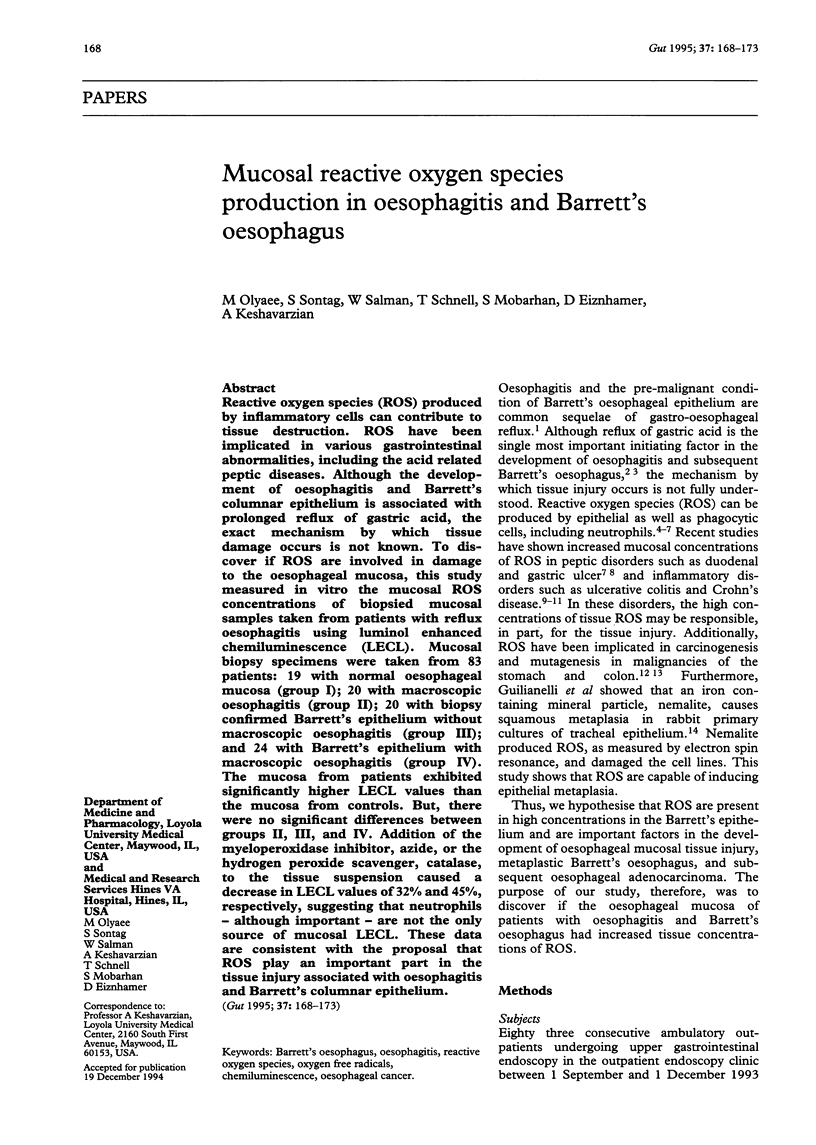
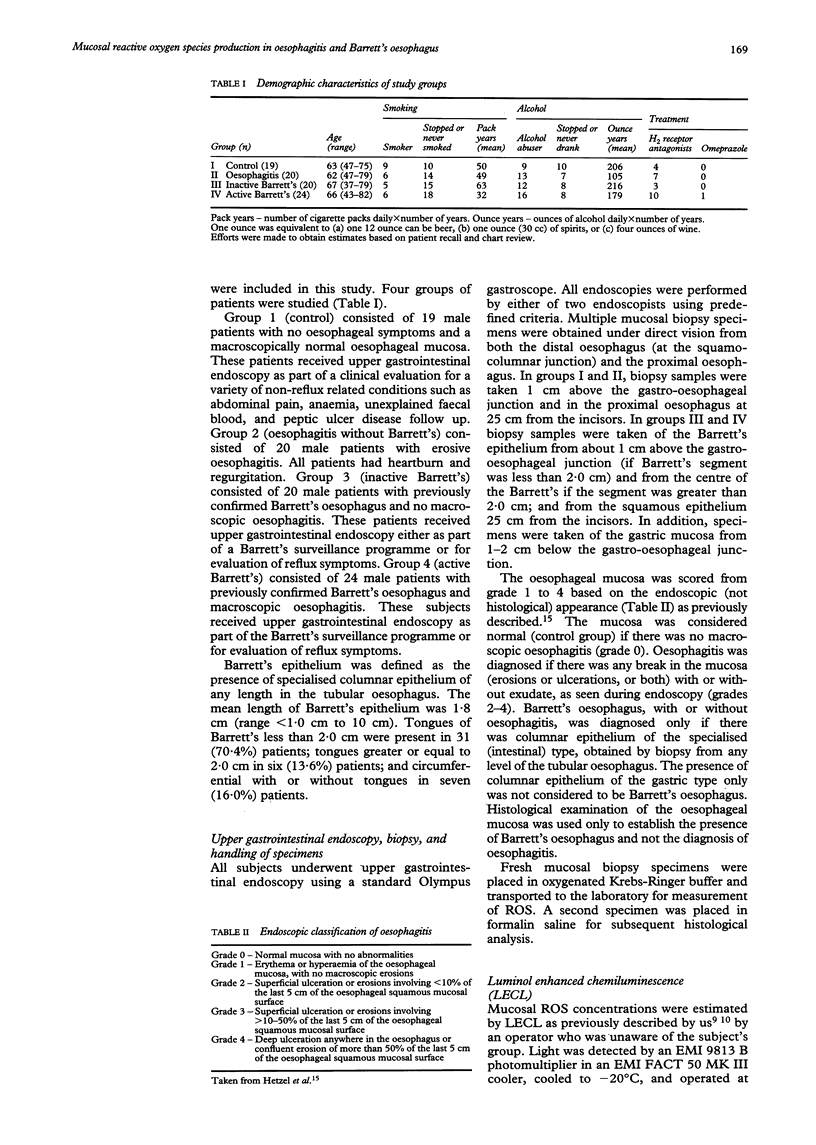
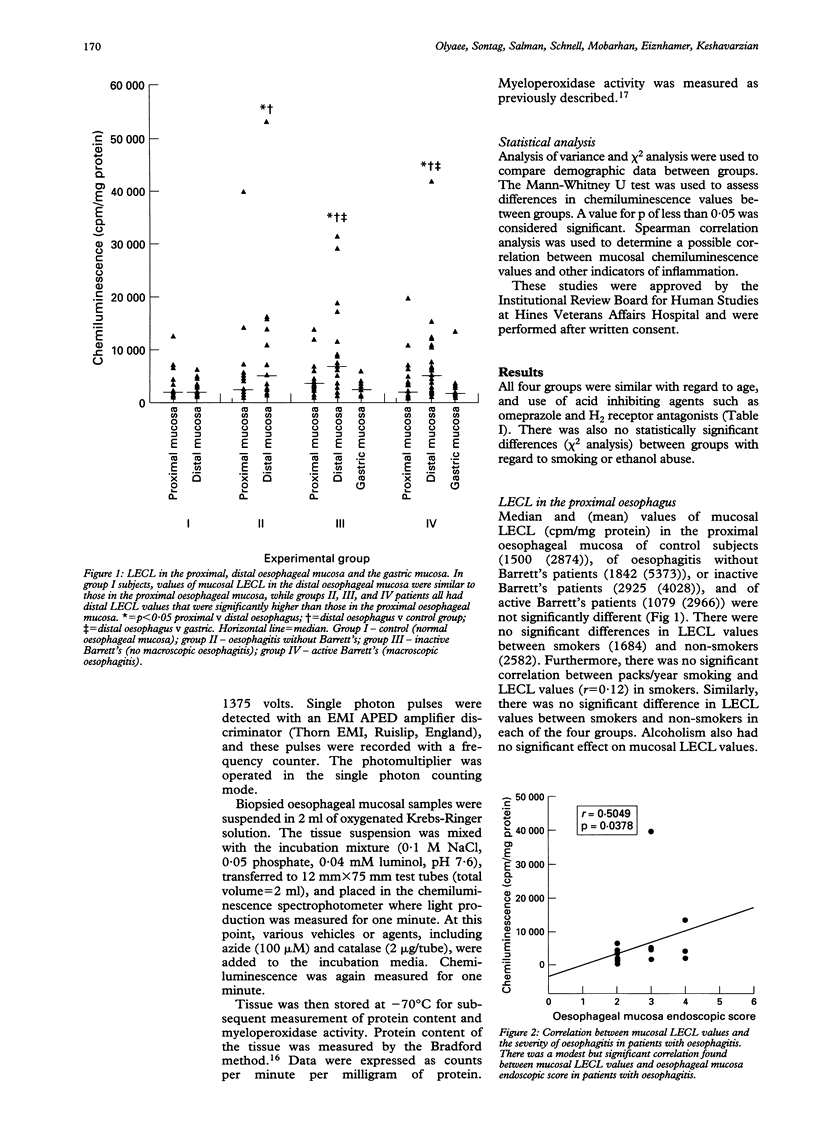
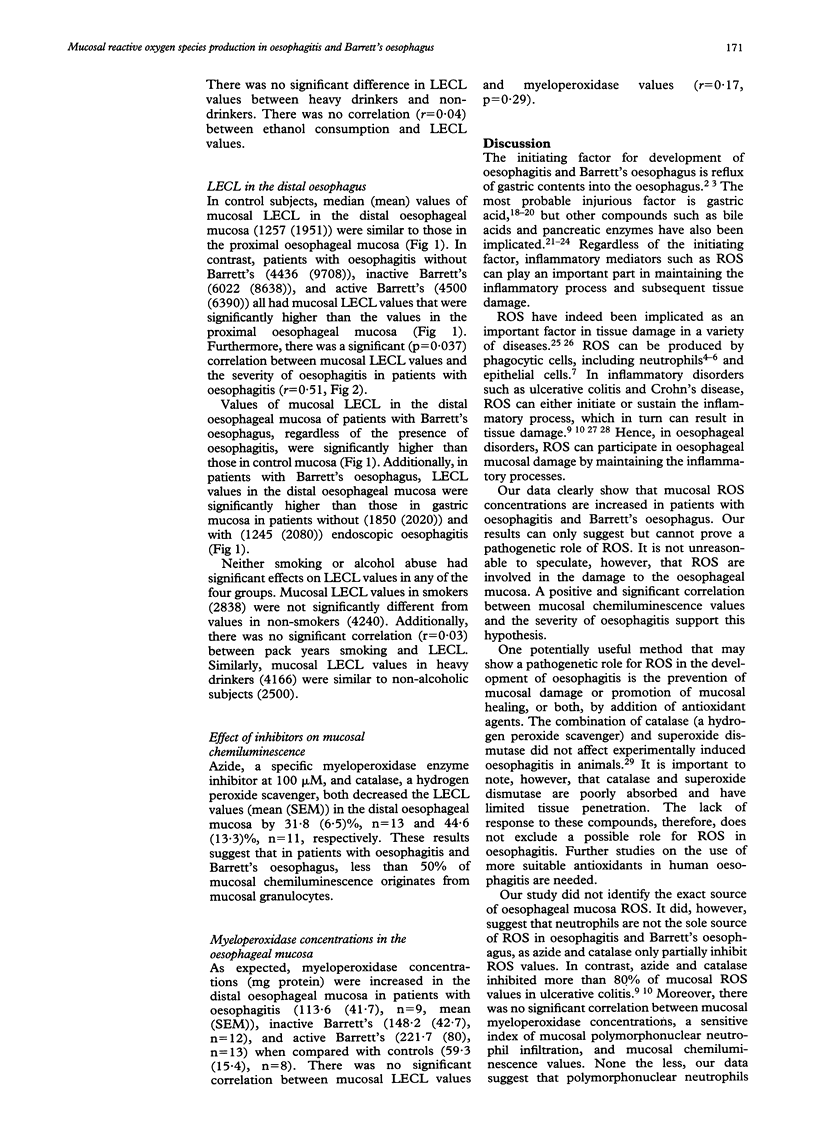
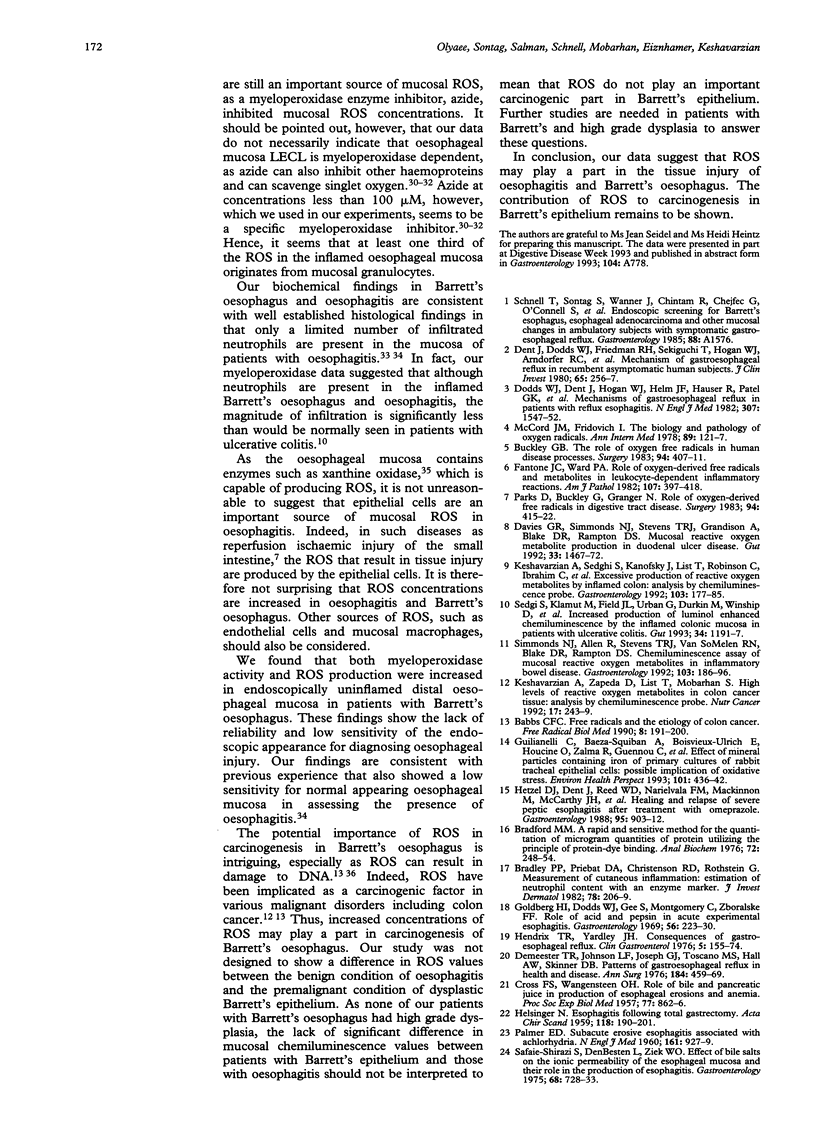
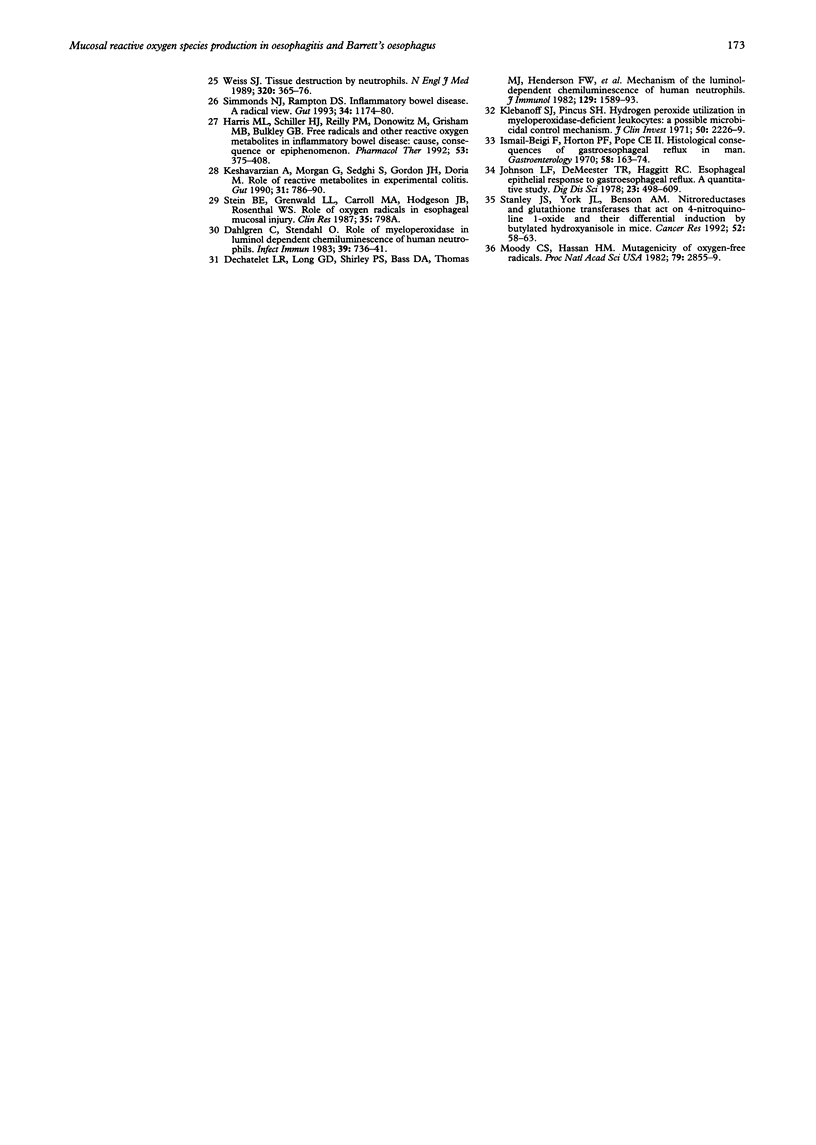
Selected References
These references are in PubMed. This may not be the complete list of references from this article.
- Babbs C. F. Free radicals and the etiology of colon cancer. Free Radic Biol Med. 1990;8(2):191–200. doi: 10.1016/0891-5849(90)90091-v. [DOI] [PubMed] [Google Scholar]
- Bradford M. M. A rapid and sensitive method for the quantitation of microgram quantities of protein utilizing the principle of protein-dye binding. Anal Biochem. 1976 May 7;72:248–254. doi: 10.1016/0003-2697(76)90527-3. [DOI] [PubMed] [Google Scholar]
- Bradley P. P., Priebat D. A., Christensen R. D., Rothstein G. Measurement of cutaneous inflammation: estimation of neutrophil content with an enzyme marker. J Invest Dermatol. 1982 Mar;78(3):206–209. doi: 10.1111/1523-1747.ep12506462. [DOI] [PubMed] [Google Scholar]
- Bulkley G. B. The role of oxygen free radicals in human disease processes. Surgery. 1983 Sep;94(3):407–411. [PubMed] [Google Scholar]
- CROSS F. S., WANGENSTEEN O. H. Role of bile and pancreatic juice in production of esophageal erosions and anemia. Proc Soc Exp Biol Med. 1951 Aug;77(4):862–866. doi: 10.3181/00379727-77-18950. [DOI] [PubMed] [Google Scholar]
- Dahlgren C., Stendahl O. Role of myeloperoxidase in luminol-dependent chemiluminescence of polymorphonuclear leukocytes. Infect Immun. 1983 Feb;39(2):736–741. doi: 10.1128/iai.39.2.736-741.1983. [DOI] [PMC free article] [PubMed] [Google Scholar]
- Davies G. R., Simmonds N. J., Stevens T. R., Grandison A., Blake D. R., Rampton D. S. Mucosal reactive oxygen metabolite production in duodenal ulcer disease. Gut. 1992 Nov;33(11):1467–1472. doi: 10.1136/gut.33.11.1467. [DOI] [PMC free article] [PubMed] [Google Scholar]
- DeChatelet L. R., Long G. D., Shirley P. S., Bass D. A., Thomas M. J., Henderson F. W., Cohen M. S. Mechanism of the luminol-dependent chemiluminescence of human neutrophils. J Immunol. 1982 Oct;129(4):1589–1593. [PubMed] [Google Scholar]
- Demeester T. R., Johnson L. F., Joseph G. J., Toscano M. S., Hall A. W., Skinner D. B. Patterns of gastroesophageal reflux in health and disease. Ann Surg. 1976 Oct;184(4):459–470. doi: 10.1097/00000658-197610000-00009. [DOI] [PMC free article] [PubMed] [Google Scholar]
- Dent J., Dodds W. J., Friedman R. H., Sekiguchi T., Hogan W. J., Arndorfer R. C., Petrie D. J. Mechanism of gastroesophageal reflux in recumbent asymptomatic human subjects. J Clin Invest. 1980 Feb;65(2):256–267. doi: 10.1172/JCI109667. [DOI] [PMC free article] [PubMed] [Google Scholar]
- Dodds W. J., Dent J., Hogan W. J., Helm J. F., Hauser R., Patel G. K., Egide M. S. Mechanisms of gastroesophageal reflux in patients with reflux esophagitis. N Engl J Med. 1982 Dec 16;307(25):1547–1552. doi: 10.1056/NEJM198212163072503. [DOI] [PubMed] [Google Scholar]
- Fantone J. C., Ward P. A. Role of oxygen-derived free radicals and metabolites in leukocyte-dependent inflammatory reactions. Am J Pathol. 1982 Jun;107(3):395–418. [PMC free article] [PubMed] [Google Scholar]
- Goldberg H. I., Dodds W. J., Gee S., Montgomery C., Zboralske F. F. Role of acid and pepsin in acute experimental esophagitis. Gastroenterology. 1969 Feb;56(2):223–230. [PubMed] [Google Scholar]
- Guilianelli C., Baeza-Squiban A., Boisvieux-Ulrich E., Houcine O., Zalma R., Guennou C., Pezerat H., Marano F. Effect of mineral particles containing iron on primary cultures of rabbit tracheal epithelial cells: possible implication of oxidative stress. Environ Health Perspect. 1993 Oct;101(5):436–442. doi: 10.1289/ehp.93101436. [DOI] [PMC free article] [PubMed] [Google Scholar]
- Harris M. L., Schiller H. J., Reilly P. M., Donowitz M., Grisham M. B., Bulkley G. B. Free radicals and other reactive oxygen metabolites in inflammatory bowel disease: cause, consequence or epiphenomenon? Pharmacol Ther. 1992;53(3):375–408. doi: 10.1016/0163-7258(92)90057-7. [DOI] [PubMed] [Google Scholar]
- Hetzel D. J., Dent J., Reed W. D., Narielvala F. M., Mackinnon M., McCarthy J. H., Mitchell B., Beveridge B. R., Laurence B. H., Gibson G. G. Healing and relapse of severe peptic esophagitis after treatment with omeprazole. Gastroenterology. 1988 Oct;95(4):903–912. doi: 10.1016/0016-5085(88)90162-x. [DOI] [PubMed] [Google Scholar]
- Ismail-Beigi F., Horton P. F., Pope C. E., 2nd Histological consequences of gastroesophageal reflux in man. Gastroenterology. 1970 Feb;58(2):163–174. [PubMed] [Google Scholar]
- Johnson L. F., Demeester T. R., Haggitt R. C. Esophageal epithelial response to gastroesophageal reflux. A quantitative study. Am J Dig Dis. 1978 Jun;23(6):498–509. doi: 10.1007/BF01072693. [DOI] [PubMed] [Google Scholar]
- Keshavarzian A., Morgan G., Sedghi S., Gordon J. H., Doria M. Role of reactive oxygen metabolites in experimental colitis. Gut. 1990 Jul;31(7):786–790. doi: 10.1136/gut.31.7.786. [DOI] [PMC free article] [PubMed] [Google Scholar]
- Keshavarzian A., Sedghi S., Kanofsky J., List T., Robinson C., Ibrahim C., Winship D. Excessive production of reactive oxygen metabolites by inflamed colon: analysis by chemiluminescence probe. Gastroenterology. 1992 Jul;103(1):177–185. doi: 10.1016/0016-5085(92)91111-g. [DOI] [PubMed] [Google Scholar]
- Keshavarzian A., Zapeda D., List T., Mobarhan S. High levels of reactive oxygen metabolites in colon cancer tissue: analysis by chemiluminescence probe. Nutr Cancer. 1992;17(3):243–249. doi: 10.1080/01635589209514193. [DOI] [PubMed] [Google Scholar]
- Klebanoff S. J., Pincus S. H. Hydrogen peroxide utilization in myeloperoxidase-deficient leukocytes: a possible microbicidal control mechanism. J Clin Invest. 1971 Oct;50(10):2226–2229. doi: 10.1172/JCI106718. [DOI] [PMC free article] [PubMed] [Google Scholar]
- Moody C. S., Hassan H. M. Mutagenicity of oxygen free radicals. Proc Natl Acad Sci U S A. 1982 May;79(9):2855–2859. doi: 10.1073/pnas.79.9.2855. [DOI] [PMC free article] [PubMed] [Google Scholar]
- Parks D. A., Bulkley G. B., Granger D. N. Role of oxygen-derived free radicals in digestive tract diseases. Surgery. 1983 Sep;94(3):415–422. [PubMed] [Google Scholar]
- Safaie-Shirazi S., DenBesten L., Zike W. L. Effect of bile salts on the ionic permeability of the esophageal mucosa and their role in the production of esophagitis. Gastroenterology. 1975 Apr;68(4 Pt 1):728–733. [PubMed] [Google Scholar]
- Sedghi S., Fields J. Z., Klamut M., Urban G., Durkin M., Winship D., Fretland D., Olyaee M., Keshavarzian A. Increased production of luminol enhanced chemiluminescence by the inflamed colonic mucosa in patients with ulcerative colitis. Gut. 1993 Sep;34(9):1191–1197. doi: 10.1136/gut.34.9.1191. [DOI] [PMC free article] [PubMed] [Google Scholar]
- Simmonds N. J., Allen R. E., Stevens T. R., Van Someren R. N., Blake D. R., Rampton D. S. Chemiluminescence assay of mucosal reactive oxygen metabolites in inflammatory bowel disease. Gastroenterology. 1992 Jul;103(1):186–196. doi: 10.1016/0016-5085(92)91112-h. [DOI] [PubMed] [Google Scholar]
- Stanley J. S., York J. L., Benson A. M. Nitroreductases and glutathione transferases that act on 4-nitroquinoline 1-oxide and their differential induction by butylated hydroxyanisole in mice. Cancer Res. 1992 Jan 1;52(1):58–63. [PubMed] [Google Scholar]
- Weiss S. J. Tissue destruction by neutrophils. N Engl J Med. 1989 Feb 9;320(6):365–376. doi: 10.1056/NEJM198902093200606. [DOI] [PubMed] [Google Scholar]


